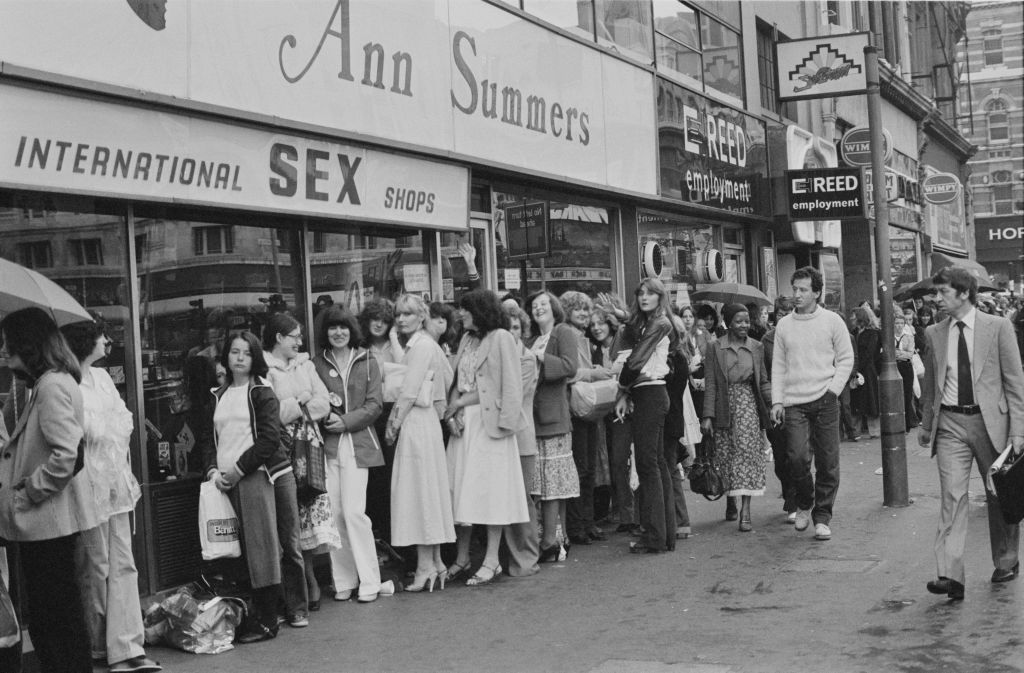I always thought that ‘Ann Summers’ was one of those made-up names created by corporate brains, like Dorothy Perkins and Ted Baker. But it turns out that Ms Summers was an actual person.
The store’s founder Michael Caborn-Waterfield named his first shop after his 19-year-old secretary Annice Summers. ‘Dandy Kim’, as he was known, had been a roguish figure around post-war London, a gentleman adventurer who’d smuggled guns into Cuba, dated Diana Dors and served time in a French jail. Described in Jeremy Scott’s memoir Fast and Louche: Confessions of a Flagrant Sinner as ‘an amusing, good-looking man’ who ‘seemed to take nothing entirely seriously’, this one-time actor and trader in black-market nylons opened his first ‘sex shop’ near Marble Arch in 1970.
During our youth, my friends and I used to loiter around our local Ann Summers. Gawping at lingerie-clad mannequins was the closest thing we had to an erotic experience – that and flicking through Kays catalogues. At the time I remember thinking ‘Why “maids’ outfits”?’ and ‘Does alluring underwear really need to be that garish?’.
When I visited the Oxford Street branch recently, I was surprised to discover that very little had changed. Apart from an updated logo – gone is the swirly pink heart motif – the bras were still as purple as I remember and maids’ attire featured heavily. All these years later and I still can’t see the appeal of what is essentially a few inches of black polyester with a doily stuck to the front.
Sexual mores may have moved on from the innocence of the early 1970s but it seems men’s tastes remain predictable. If my local Ann Summers is anything to go by there is nothing we men love more than frilliness. Why frills should have become so synonymous with male desire is anyone’s guess.

When brothers Ralph and David Gold purchased the business in 1971, they transformed the original Marble Arch shop into the high street brand we know today. There are now 140 Ann Summers shops across the UK, Spain and Ireland, and the company has an annual turnover of more than £100 million. Times may have changed but chief executive Jacqueline Gold, who took over from her father in 1981, knows there will always be a demand for such weirdly deconstructive attire as crotchless pants. ‘Aphrodisiac Stimulating Lip Gloss’, ‘Caramel Flavoured Body Paint’ and ‘Woo Woo Cranberry Wipes’ may sound bonkers but Ann Summers has an eye for what sells. How else do you explain the continued success of a high street ‘adult store’ in the age of the internet?
As well as catering for ‘gentlemen’ clients, Gold knows what women want, too. Her Party Plan concept, introduced more than 40 years ago, has been famously successful. Essentially Tupperware parties but with saucy pants, they are still as popular as ever, although they have been rebranded for feminists. ‘Parties’ are now called ‘Sisterhoods’ while ‘party planners’ have been renamed ‘ambassadors’. A Sisterhood ambassador can earn around £1,000 a month from hosting parties. Gold says she wants women ‘to reclaim their sex lives’ by offering them the opportunity to discuss sex toys and polyester G-Strings, all within the safety of a women-only group, aided of course by copious amounts of bubbly. I’ve always suspected that the real pleasure of these parties comes not from the erotic possibilities of edible underwear, but from laughing at the absurdity of it all.
In 2006, Muslim groups complained about the release of an Ann Summers blow-up doll named Mustafa Shag, claiming that the doll was offensive to Muslims. Mustafa is one of the names given to the Prophet Mohamed. I hope Allah saw the funny – and frilly – side.
And as for the real Ann Summers? Following a fierce row with Caborn-Waterfield, the two parted company. She grew unhappy about her association with the brand, complaining that she did not give permission for the more sexually explicit products to be sold under her name and was not paid the initial sum agreed with Caborn-Waterfield. She married an American millionaire, but after being widowed she spent the final years of her life as a virtual recluse in the Italian countryside before her death from cancer in 2012. Her name, though, seems likely to remain visible on our high streets for a long time to come.






Comments